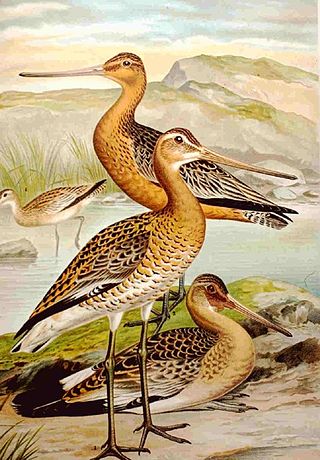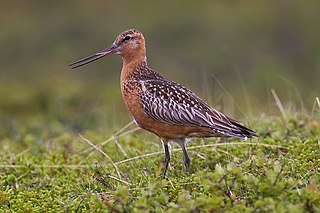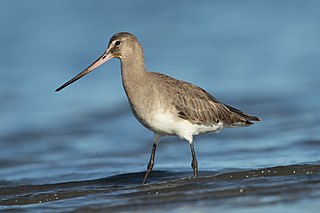
The godwits are a group of four large, long-billed, long-legged and strongly migratory waders of the bird genus Limosa. Their long bills allow them to probe deeply in the sand for aquatic worms and molluscs. In their winter range, they flock together where food is plentiful. They frequent tidal shorelines, breeding in northern climates in summer and migrating south in winter. A female bar-tailed godwit made a flight of 29,000 km (18,000 mi), flying 11,680 kilometres (7,260 mi) of it without stopping. In 2020 a male bar-tailed godwit flew about 12,200 kilometres (7,600 mi) non-stop in its migration from Alaska to New Zealand, previously a record for avian non-stop flight. In October 2022, a 5 month old, male bar-tailed godwit was tracked from Alaska to Tasmania, a trip that took 11 days, and recorded a non-stop flight of 8,400 miles (13,500 km).

The marbled godwit is a large migratory shorebird in the family Scolopacidae. On average, it is the largest of the four species of godwit.

The bar-tailed godwit is a large and strongly migratory wader in the family Scolopacidae, which feeds on bristle-worms and shellfish on coastal mudflats and estuaries. It has distinctive red breeding plumage, long legs, and a long upturned bill. Bar-tailed godwits breed on Arctic coasts and tundra from Scandinavia to Alaska, and overwinter on coasts in temperate and tropical regions of Australia and New Zealand. The migration of the subspecies Limosa lapponica baueri across the Pacific Ocean from Alaska to New Zealand is the longest known non-stop flight of any bird, and also the longest journey without pausing to feed by any animal. The round-trip migration for this subspecies is over 29,000 km (18,020 mi).

The black-tailed godwit is a large, long-legged, long-billed shorebird first described by Carl Linnaeus in 1758. It is a member of the godwit genus, Limosa. There are four subspecies, all with orange head, neck and chest in breeding plumage and dull grey-brown winter coloration, and distinctive black and white wingbar at all times.

The Hudsonian godwit is a large shorebird in the sandpiper family, Scolopacidae. The genus name Limosa is from Latin and means "muddy", from limus, "mud". The specific haemastica is from Ancient Greek and means "bloody". An 18th-century name for this bird was red-breasted godwit. The English term "godwit" was first recorded in about 1416–7 and is believed to imitate the bird's call.

Polyorthini is a tribe of moths in the family Tortricidae.
Histura is a genus of moths in the family Tortricidae.

Ancylis is a genus of moths belonging to the subfamily Olethreutinae of the family Tortricidae.
Nätsi-Võlla Nature Reserve is a nature reserve situated in western Estonia, in Pärnu County, made up of several bogs that together form the largest bog area in Pärnu County.
Histura perseavora is a species of moth of the family Tortricidae. It is found in Guatemala.
Histura xanthotypa is a species of moth of the family Tortricidae. It is found in Paraná, Brazil.
Histura bicornigera is a species of moth of the family Tortricidae. It is found in Colombia.
Histura boliviana is a species of moth of the family Tortricidae. It is found in Bolivia and Ecuador.
Histura chlorotypa is a species of moth of the family Tortricidae. It is found in Paraná, Brazil.
Histura cuprata is a species of moth of the family Tortricidae. It is found in Guyana and Brazil.
Histura doriae is a species of moth of the family Tortricidae. It is found in Santa Catarina, Brazil.
Histura hirsuta is a species of moth of the family Tortricidae. It is found in Panama.
Histura berylla is a species of moth of the family Tortricidae. It is found in Veracruz, Mexico.
Histura luteochlora is a species of moth of the family Tortricidae. It is found in the Federal District of Brazil.
Histura brunneotypa is a species of moth of the family Tortricidae. It is found in Argentina.






